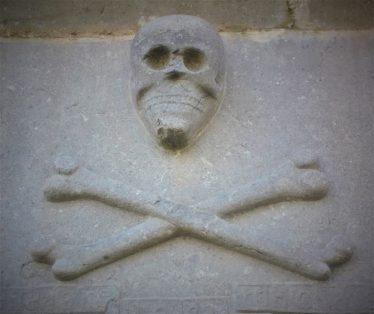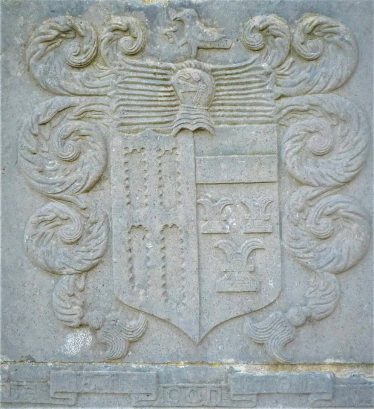10 Katherine Holcroft


In Ballinrobe our oldest, elegant, wall-mounted memorial slab is to a woman and located on the north wall outside our Library. Katherine Holcroft (b 1624) died in 1668; her memorial slab’s prominent position facing the original entrance from Glebe Street, suggests the high regard with which this lady was held, by her husband and the Ballinrobe colonial community. The wealth associated with and acquired by the Holcroft family was detrimental for the indigenous Irish community and is an intrinsic part of our heritage.
Born Katherine Ormsby at Tobervaddy, Co Roscommon, the eight of 10 children of Edward Ormsby (1590-1664) and Sarah Bridges (b 1588) (married 1608). Her brothers were Arthur, Robert and George; all three married together with her sisters Mary, Ann, Margaret and Suzanne and an unnamed sister Sarah appears to have been single.
Katherine married Sir Charles Holcroft one of the Commissioner at the time of the Acts of Settlement and Restoration in Ireland. They lived at Cloonagashel Castle, just outside Ballinrobe at a time of great upheaval in the area.
To give a little context the Holcrofts were certainly known, and probably friends of fellow Commissioner James Cuffe of Ballinrobe, who was also a Loughrea Commissioner and Secretary; with six clerks, messenger, and a doorkeeper[1]. They would have had the choice of the best lands being dispersed to English settlers. In 1663 the estate of Thomas Nolan, was confiscated, and granted in 1655 by the Cromwellian Commissioners to James Cuff. We see the first evidence of Cuff Family, the local landlords, being in residence at Lakeview prior to their move to Creagh in Ballinrobe from a copy letter dated 1660 from Ms Cuff to her children Theresa and John Cuff still in England[2].
Charles Holcroft appears to have been a fair and independent minded man indicated by the stance he took in relation to a trial when he voted in favour of acquittal against overwhelming odds.
A special commission was issued and directed by Sir Charles Coote, President of the Connaught Presidency Court and ten other commissioners including Charles Holcroft to try Lord Mayo, Theobald, 3rd Viscount Mayo for murder and being an accessory to the murder of diverse persons on the Bridge of Shrule, Co Galway on Sunday 13th February 1641/2. In spite of the prisoner’s Counsel, having commented on the total lack of evidence called for acquittal seven were in favour of conviction with Charles Holcroft showing his mettle and one of the only two that voted for acquittal[3]. Unfortunately execution was carried out that year.
Katherine’s death and subsequent burial at what was originally Tempall Ruadan (now the Library) on the ‘hill of the red cow’ leaves no doubt that the original church was taken over as an Anglican Church and in use at this time. The Rev John Courtney MA, one of the Kenny of Ballinrobe’s ancestors, was Rector and Vicar Ballinrobe & Ballinchalla in 1666 till his death in 1671. King Charles 11 was on the throne at this time.
The new settlers’ main purpose was one of domination of the local community and establishing the trappings of colonialism.
However, her memorial reminds of us of a turbulent era of Ballinrobe’s history and heritage and also assists in establishing the the much earlier church that stood on this site. Its early conversion c 1660s from a Catholic church to a Protestant one, which was remodeled c 1850s when its old box pews and the exterior stone steps that led up to its galleries were removed, helps establish its earlier date of use.
Further reading: Staunton, Staunton Ballinrobe – Aspects of a A Visual History, Ballinrobe Historical & Archaeological Society 2014
Available in Martin Murphy’s Newsagents, Ballinrobe
The Mayo Bookstore, Castlebar Co Mayo
[1] List taken from The State of Protestants of Ireland under King James Government London 1691, MS Vol. F 1.14 Trinity College, Dublin, cited in O’Hart, J., The Irish & Anglo Irish Landed Gentry, Irish University Press, Shannon, 1969, p. 235.
[2] See the Kenny Papers at Castlebar County Library.
[3] Burke, Oliver Joseph (1825-1889) Anecdotes of the Connaught Circuit from its foundation in 1604 to close upon the present time (1885). Hodges Figgis, Dublin, p 33

No Comments
Add a comment about this page